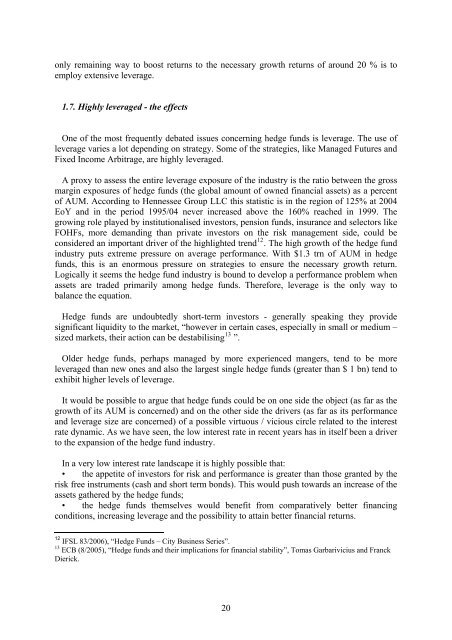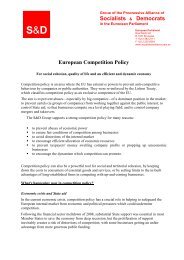Executive summary - Udo Bullmann
Executive summary - Udo Bullmann
Executive summary - Udo Bullmann
- No tags were found...
You also want an ePaper? Increase the reach of your titles
YUMPU automatically turns print PDFs into web optimized ePapers that Google loves.
only remaining way to boost returns to the necessary growth returns of around 20 % is toemploy extensive leverage.1.7. Highly leveraged - the effectsOne of the most frequently debated issues concerning hedge funds is leverage. The use ofleverage varies a lot depending on strategy. Some of the strategies, like Managed Futures andFixed Income Arbitrage, are highly leveraged.A proxy to assess the entire leverage exposure of the industry is the ratio between the grossmargin exposures of hedge funds (the global amount of owned financial assets) as a percentof AUM. According to Hennessee Group LLC this statistic is in the region of 125% at 2004EoY and in the period 1995/04 never increased above the 160% reached in 1999. Thegrowing role played by institutionalised investors, pension funds, insurance and selectors likeFOHFs, more demanding than private investors on the risk management side, could beconsidered an important driver of the highlighted trend 12 . The high growth of the hedge fundindustry puts extreme pressure on average performance. With $1.3 trn of AUM in hedgefunds, this is an enormous pressure on strategies to ensure the necessary growth return.Logically it seems the hedge fund industry is bound to develop a performance problem whenassets are traded primarily among hedge funds. Therefore, leverage is the only way tobalance the equation.Hedge funds are undoubtedly short-term investors - generally speaking they providesignificant liquidity to the market, “however in certain cases, especially in small or medium –sized markets, their action can be destabilising 13 ”.Older hedge funds, perhaps managed by more experienced mangers, tend to be moreleveraged than new ones and also the largest single hedge funds (greater than $ 1 bn) tend toexhibit higher levels of leverage.It would be possible to argue that hedge funds could be on one side the object (as far as thegrowth of its AUM is concerned) and on the other side the drivers (as far as its performanceand leverage size are concerned) of a possible virtuous / vicious circle related to the interestrate dynamic. As we have seen, the low interest rate in recent years has in itself been a driverto the expansion of the hedge fund industry.In a very low interest rate landscape it is highly possible that:• the appetite of investors for risk and performance is greater than those granted by therisk free instruments (cash and short term bonds). This would push towards an increase of theassets gathered by the hedge funds;• the hedge funds themselves would benefit from comparatively better financingconditions, increasing leverage and the possibility to attain better financial returns.12 IFSL 83/2006), “Hedge Funds – City Business Series”.13 ECB (8/2005), “Hedge funds and their implications for financial stability”, Tomas Garbarivicius and FranckDierick.20





